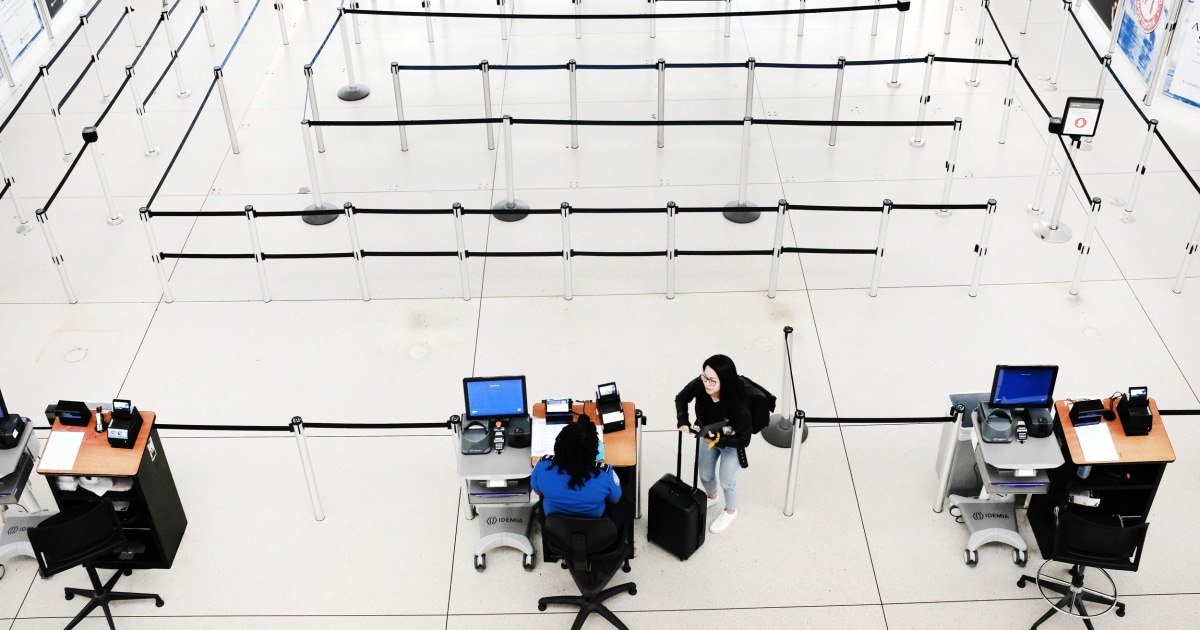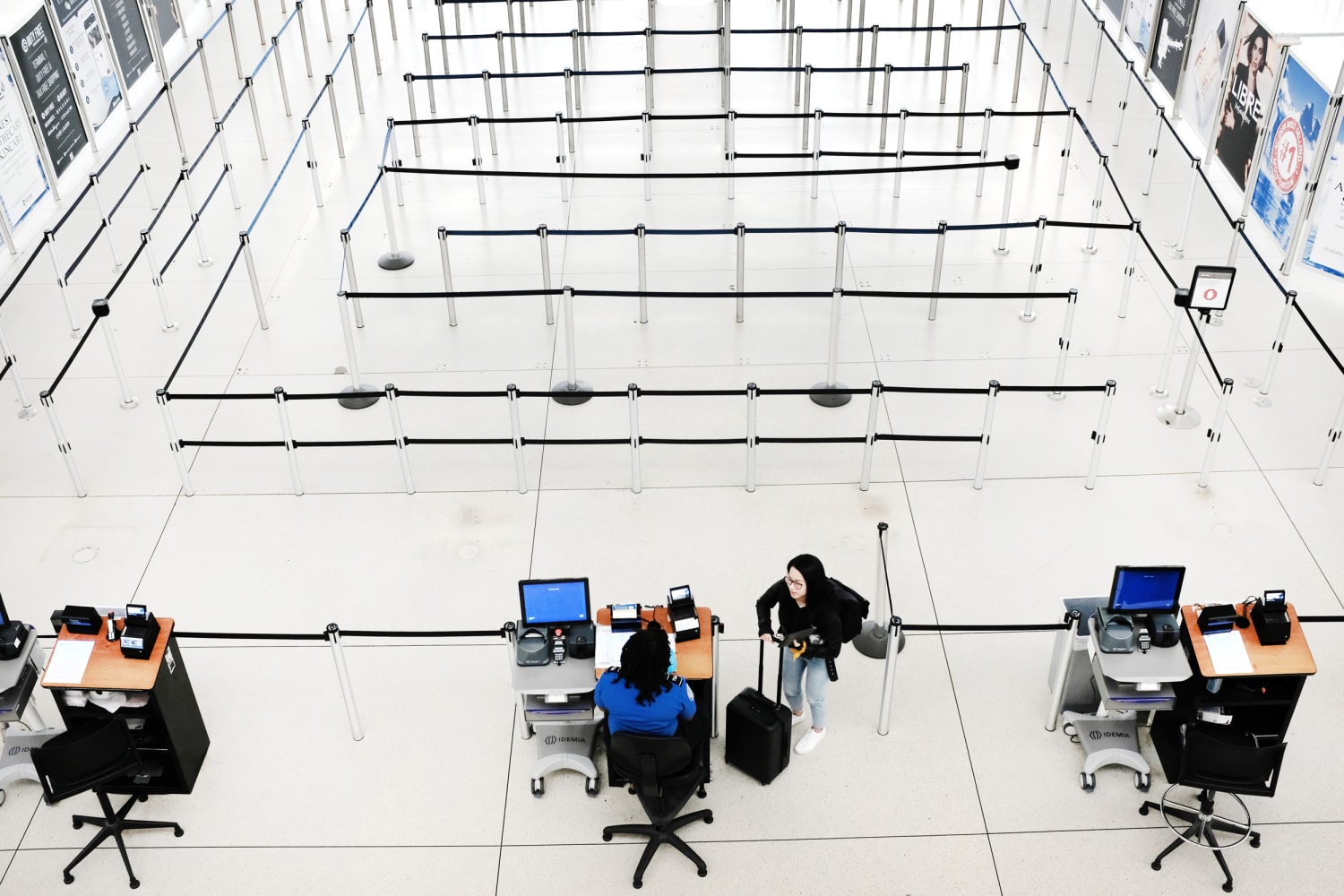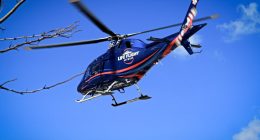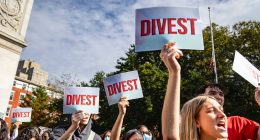
In a nearly 17-year career with U.S. Customs and Border Protection, Officer Omar E. Palmer had encountered plenty of precarious situations, from suitcases filled with weapons and drugs to disorderly passengers in John F. Kennedy Airport’s international terminal.
“I would often get calls, when he would get off work in the middle of the night — about what happened, or who he met, or a particular seize that happened,” said Yvette Williams, Palmer’s longtime friend and significant other. “Omar was fearless.”
Williams, living in Ohio where she teaches a college English course, began to feel fearful and helpless from afar. Palmer, who lived in New York with his aging mother, said long-term quarantining wasn’t possible, and he sent her selfies in personal protective equipment to ease her worries.
“His favorite phrase to me was, ‘I am not some delicate flower,’” Williams said. “I said, ‘You’re not a delicate flower, but you’re a human being.’”
Williams’ gut feeling was right: Palmer contracted the virus at the airport, and died in early May after a monthlong stay in intensive care.
Palmer was among hundreds of federal personnel whose responsibilities were adjusted to include evaluating the health of passengers arriving from overseas. “U.S. Customs and Border Protection Officer Omar Palmer performed many assigned tasks with professionalism and integrity, his passing was tragic and we kindly ask that you respect his family’s privacy during this difficult time,” an agency spokesman at JFK said.
The goal of the screening program was to identify and isolate sick travelers who were bringing the virus into the country, in hopes that it would thwart any possible community spread.
In interviews with dozens of federal employees and task force officials over four months, CNBC learned that the program proved not only ineffective but dangerous from its earliest days. One former official on the White House coronavirus task force estimated that that three- to four-dozen personnel were infected by the end of May. To compare, nine travelers out of hundreds of thousands screened in the program were detected to have been infected by the end of September.
Yet the White House chose not to dismantle it, in a bid to avoid worrying the public.
″‘We are doing everything we possibly can to protect the homeland’ — that was the message that was being sent by continuing the screenings,” said a former Health and Human Services official, speaking on condition of anonymity to discuss private deliberations. “But at some point you have to adapt. You have to say: ‘This isn’t working.’”
The White House, the National Security Council, the departments of Health and Human Services and Transportation, and the Centers for Disease Control and Prevention did not respond to requests for comment. The office of the vice president, who was appointed to lead the task force in February once the system was in place, declined to comment.
Quick spread
The plan, hatched by the White House task force in mid-January, began modestly enough: Travelers whose itineraries originated in China would be diverted to one of three airports, where a few dozen screeners would evaluate their symptoms.
As the virus spread west through the Middle East and Europe, the program swelled to 15 airports, flights from 31 countries, and some 750 screeners and support personnel. At the program’s peak, agents were conducting roughly 30,000 screenings daily, according to Centers for Disease Control and Prevention data.
The Department of Homeland Security staffed the first line of defense: Customs and Border Protection agents, outfitted in gloves, goggles and N95 masks, would check temperatures and administer a flu-symptom questionnaire to arriving passengers, in addition to checking passports. Anyone who registered above-grade would be sent for further evaluation in rooms staffed by nearly 500 agency analysts and outside contractors organized by the CDC.
Publicly, the Trump administration attempted to foster confidence in the strategy, sending the country’s top health officials to the White House briefing room to field questions from reporters.
“These prudent and targeted actions will decrease the pressure on public health officials screening incoming travelers, expedite the processing of U.S. citizens returning from China, and ensure resources are focused on the health and safety of the American people,” Health and Human Services Secretary Alex Azar said on Jan. 31, two weeks after the program began.
But behind the scenes, early data showed the program was not doing what it purported to do.
“We weren’t finding anybody. I mean, we were finding, like, zero people,” said Joe Grogan, who was the director of the White House Domestic Policy Council until May. “It became pretty clear relatively quickly that it was, from a public health perspective, as far as identifying people who were Covid positive, it was a failure.”
The numbers were indeed near zero. According to CDC data, screeners evaluated 776,044 passengers from mid-January to mid-September. Only nine positive cases of coronavirus resulted from the screens, or 0.001%.
‘A pretty stark data point’
The nature of this virus — in particular, its widespread transmission by healthy-looking people — rendered the screeners’ search for visible symptoms useless.
“The people who actually had a temperature, that the net actually caught,” the former HHS official says, “I mean, it was so minimal.”
What’s more, the nature of the asymptomatic spread meant contagious travelers were going undetected, while exposing the airport staff to the virus at high rates, according to Grogan and three task force officials who spoke on the condition of anonymity because they still serve in the administration.
“It was a pretty stark data point,” Grogan told CNBC in an exclusive interview to discuss the program. “It was relayed out that — not only are we not finding anybody, we are getting more CDC and DHS employees infected with Covid at the airports than we are finding people.”
As the nation’s largest employer, it’s no surprise the government saw a high incidence of Covid cases. After the Postal Service, the Department of Homeland Security saw the highest infection rate among federal agencies, with more than 4,000 at Customs and order Protection alone. CBP did not respond to a request for a breakdown of how many of those cases occurred at airports.
Unlike other agencies, the CDC does not provide information about agency infections on a publicly available dashboard. When requested by CNBC, the CDC declined to provide data about infection rates among screeners. The CDC also declined requests for interviews with top officials, including Director Dr. Robert Redfield and Dr. Marty Cetron, to discuss their concerns about the program.
‘We were aware they were getting sick’
The ineffectiveness of the program became widely understood by mid-March, leading the White House and federal agencies to weigh dismantling it and reallocating resources to other hot spots, according to six task force officials involved in the discussions. These officials requested anonymity because they still serve in, or do business with, the administration and did not have authorization to discuss the matter.
One task force official said the debate was not about the screeners themselves. “We were aware they were getting sick, but it was whether [the testing of passengers] was effective,” the official said.
A second task force official said the questions of whether to end the funneling and disperse the CBP and CDC personnel to other functions was “a running discussion for a couple of months,” beginning in April.
A third task force official said the decision to keep it intact was made because “it presents a show of force” to the American people, “and it didn’t cost a lot, relatively speaking.” A fourth official said the role of these screeners was an important “deterrent” for otherwise-sick passengers to board a flight.
Ken Cuccinelli, who as acting deputy secretary of the Department of Homeland Security served on the task force and helped to execute its efforts, acknowledged that there were travelers the program simply missed due to asymptomatic spread. He also suggested that responsibility for the program’s shortcomings is shared across the government.
“We were the experts on transportation logistics, but we did not make the medical decisions,” Cuccinelli told CNBC, who said his workforce was handicapped by training limited to “eyeballing” passengers, and a tool set limited to taking temperatures. “Some of this was done — or continued — because it did catch some people.”
Three task force officials, including Grogan, recalled a tension between the Department of Homeland Security — whose employees served an essential function at airports regardless of the pandemic — and the CDC, whose leaders were early advocates of reshuffling its people away from the airports to serve nursing homes and other critical needs around the country.
“If you just pulled all those CDC public health employees out and said, ‘You’re on your own,’” Grogan said, ”[DHS] wouldn’t have been comforted by that.”
CDC declined to comment on the discussion. A report released in November described the program as “resource-intensive, with low yield” and concluded that “symptom-based screening programs are ineffective.”
Cuccinelli said it was unconscionable that DHS would have withdrawn its workers at a time the country was facing significant threats.
“The idea that we wouldn’t do anything strikes me as unsupportable — that’s not even plausible Monday morning quarterbacking,” he said.
The program remained largely intact until Sept. 13, when the CDC announced its official end — eight months after its inception and six months after officials recall learning it wasn’t working.
And while the number of federal workers who fell ill was not an eye-popping amount, “it was enough to make you concerned with what’s going on,” said the former HHS official.
‘Risk on the front line’
While far greater than the rate of passengers detected, Cuccinelli told CNBC he didn’t find the incidence of infection among his workforce concerning: The coronavirus transmission rate was roughly the same as the broader public, and the agency couldn’t be sure they didn’t pick it up outside of work.
“There’s always risk for people on the front line,” Cuccinelli said. “But what we have found, including with our own front-line folks is that those individuals tended to be the ones who have caught the virus have done so at rates similar to the communities in which they were working.”
Unions like the American Federation of Government Employees lobbied lawmakers to include in the Covid stimulus bill “automatic presumption of workplace illness” to help workers access greater sick leave and workers’ compensation. Until the final text of the $900 billion relief deal is made public, it remains unclear whether lawmakers included these protections. They have not been major items in negotiations.
Customs and Border Protection had not recorded an officer death since 2015. In 2020, there have been nine deaths, all due to Covid-19. Memorial pages set up in remembrance of Palmer and his colleague CK Yan said the two men contracted the virus while at work.
Palmer lived with his mother, herself a former DHS employee, and took strict precautions to protect her health, Williams said.
He limited his contact, and wore gloves and masks. On April 1, he planned to visit Williams’ adult daughters at their home in Brooklyn to drop off a package of N95 masks and gloves, then in short supply around the country. Instead, he called to notify her he had be quarantining after being exposed to Covid at the airport.
By the end of the week, he was in intensive care, and two weeks later, on a ventilator and in a coma.
Palmer died May 4. He was 40. Williams visits his grave, and she wonders what government brass could have done to save him.
“It’s irresponsible. It’s murder,” Williams said, holding back tears. “When you know better, you should do better. There is no excuse.”
Source: | This article originally belongs to Nbcnews.com










